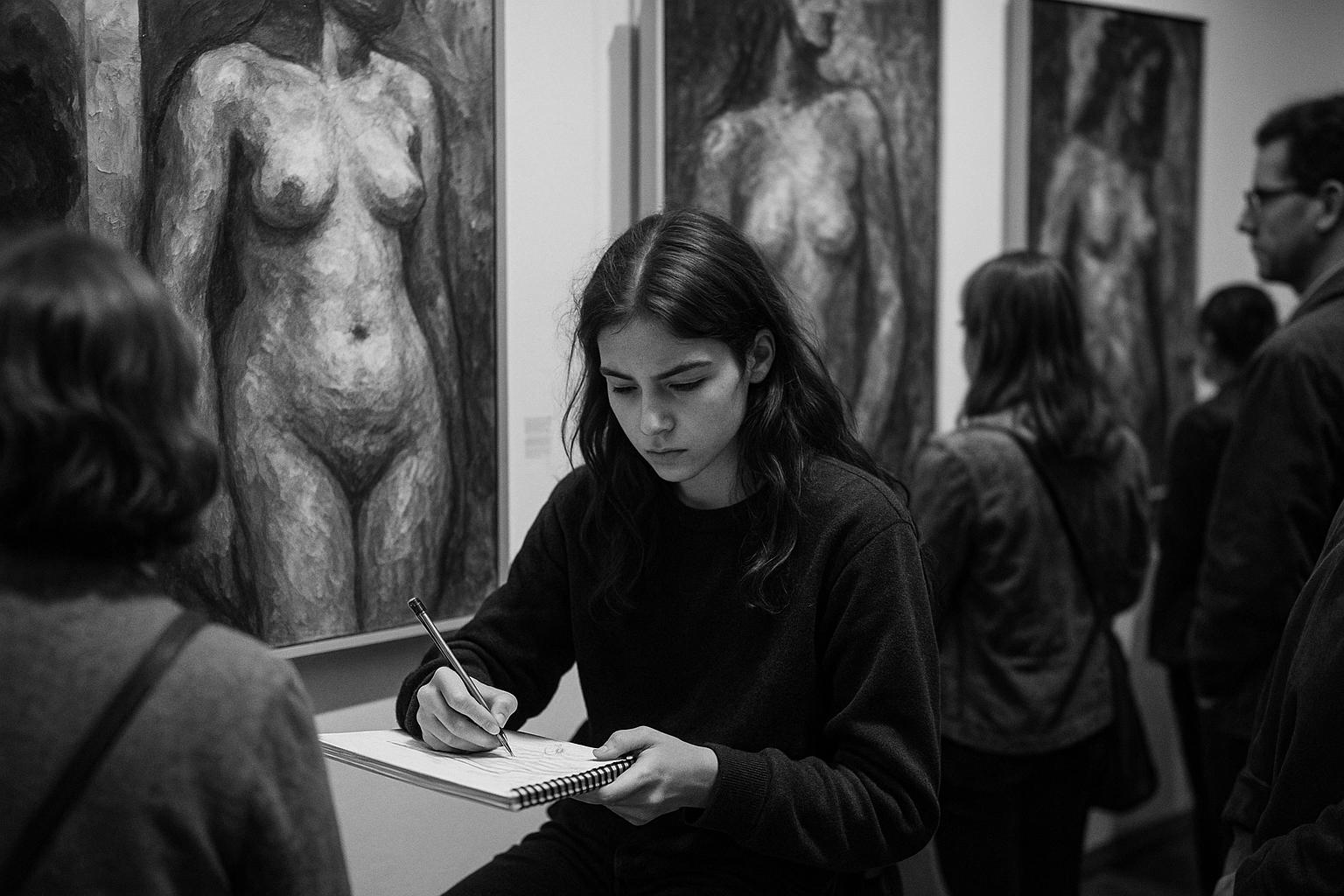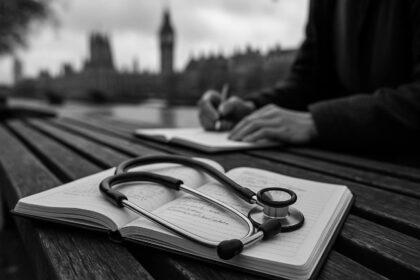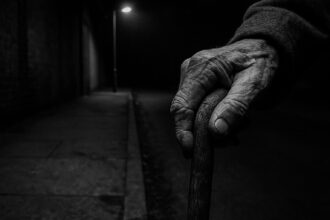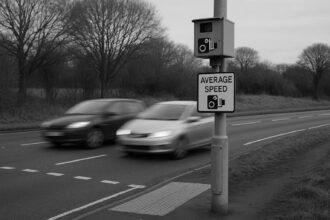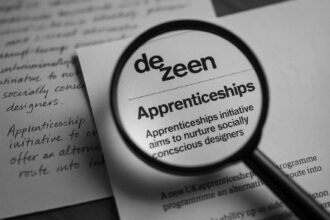Jenny Saville’s exhibition The Anatomy of Painting at the National Portrait Gallery draws enthusiastic young visitors with its bold, unfiltered depictions of the female form, challenging beauty ideals and providing a powerful counterpoint to digital imagery, all while arts education faces severe funding cuts across the UK.
Jenny Saville’s exhibition, The Anatomy of Painting, currently on display at the National Portrait Gallery, offers a stirring exploration of the human form that has deeply resonated with a new generation of art students. The show is notably alive with enthusiastic teenagers, many armed with sketchbooks and keen to capture the essence of Saville’s bold portraits. These young visitors are drawn to the raw, textured, and emotionally vivid depictions of female bodies that challenge contemporary beauty ideals, especially in a digital age dominated by polished, idealised images. One of the attendees, seventeen-year-old Laurence, praised the “messy side” of Saville’s art and its emotional intensity, while his classmate Georgia felt “positively overwhelmed” by the vibrant and unsettling beauty of her self-portrait Propped, an early work from her Glasgow School of Art days. This painting boldly confronts traditional representations of women, merging vulnerability and strength, and includes a provocative inversion of a feminist text that warns against repeating oppressive historical narratives.
The exhibition’s appeal lies not only in its challenging portrayal of female flesh but also in its technical prowess and emotional depth. Saville’s work spans candid explorations of the body—from wounded faces and stained skin to the intimate truths of motherhood—pushing the limits of paint and charcoal to create visceral images that arrest and move the viewer. The monumental impact of her art is palpable when seen live, far removed from the airbrushed images commonly found in media or the restrained portraits gathered in traditional museums. This power especially resonates now, at a time when funding cuts across the UK have imperilled arts education, reducing opportunities for many aspiring artists, particularly those from less privileged backgrounds. Remarkably, the exhibition is made accessible free for visitors aged 25 and under, thanks to a private donor, ensuring that young people from diverse backgrounds can engage with and be inspired by Saville’s work.
Beyond the classroom enthusiasm and youthful discussions, critical reception acknowledges the thematic and stylistic evolution in Saville’s oeuvre. Her earlier work, raw and physically intense, has gradually folded into more intimate portrayals, such as tender reflections on motherhood and explorations of the body in states of change. One particularly poignant and critical piece, Aleppo (2017–18), graphically communicates the harrowing human consequences of conflict, drawing on the Syrian war to produce a haunting image of vulnerability. However, some critics have noted that her recent portraits, while still demonstrating considerable technical skill, sometimes lack the same emotional immediacy that characterised her early pieces. This shift underscores her ongoing artistic evolution, reflecting a complex dialogue between personal transformation and broader social themes.
The exhibition also traces Saville’s art historical influences and situates her work within a lineage of painters such as Rembrandt, Titian, and Bacon, whom she cites as key inspirations. Her engagement with these traditions is evident in her fearless confrontation of flesh and identity, a pursuit that began with works like Propped—a self-portrait that not only launched her career but also became a landmark in feminist art. This painting’s impact was magnified by its inclusion in the 1997 Sensation exhibition and its combination of bold physicality with intellectual depth, exemplified in the inclusion of feminist philosopher Luce Irigaray’s words. Propped’s importance is further reflected in its high-profile sale at auction, marking its lasting significance in contemporary art.
To accompany the exhibition, a comprehensive monograph titled Jenny Saville: The Anatomy of Painting will be published in September 2025. This volume promises to delve deeper into her artistic journey through contributions by notable critics and scholars and includes new photographic studio images. It serves as an essential resource for understanding the full breadth of her work and influence.
In a broader cultural context, Saville’s exhibition has been highlighted as a pivotal event in London’s 2025 art calendar, alongside other major shows, affirming her continued prominence and the relevance of her themes in today’s artistic landscape. As a retrospective, it not only celebrates a formidable career but also invites reflection on how painting remains a powerful medium for confronting societal norms and personal identity in an age of digital saturation.
 Reference Map:
Reference Map:
- Paragraph 1 – [1], [6], [7]
- Paragraph 2 – [1]
- Paragraph 3 – [2], [7]
- Paragraph 4 – [4], [6]
- Paragraph 5 – [5]
- Paragraph 6 – [3], [4]
Source: Noah Wire Services
- https://www.theguardian.com/artanddesign/2025/jun/30/schoolclass-jenny-saville-portraits – Please view link – unable to able to access data
- https://www.ft.com/content/54e06f7b-2369-4448-b15e-61b9a4144673 – The Financial Times reviews ‘Jenny Saville: The Anatomy of Painting’ at the National Portrait Gallery, highlighting the exhibition’s showcase of Saville’s emotionally charged and technically masterful figure paintings. Central to the exhibition is the haunting ‘Aleppo’ (2017–18), a tender yet devastating depiction of war’s human toll, inspired by the Syrian conflict. The review also discusses Saville’s thematic evolution, from raw physicality to intimate portrayals of motherhood and increasingly abstract depictions of bodies in motion and transformation. While her recent portraits display technical skill, they are critiqued for lacking the emotional depth of earlier pieces.
- https://www.wallpaper.com/art/exhibitions-shows/london-art-exhibitions – Wallpaper* magazine highlights ‘Jenny Saville’s bold portrayals of the human form at the National Portrait Gallery’ as a key exhibition in London for July 2025. The article provides an overview of various art exhibitions in London, including solo shows by Jenny Saville, Megan Rooney, and Yoshitomo Nara, as well as retrospectives for Do Ho Suh and Paul Thek. The piece also mentions group exhibitions and immersive experiences, offering a comprehensive guide to London’s art scene during that period.
- https://www.ft.com/content/ea99e602-3e3c-4d89-b479-360ced70ea1c – The Financial Times features an interview with Jenny Saville, discussing her upcoming retrospective at the National Portrait Gallery in London. The exhibition marks the first major UK showcase of her work, featuring around 50 pieces spanning her career. Saville reflects on her rise to prominence in the 1990s, her exploration of flesh, gender, and identity, and her influences from art history figures like Rembrandt, Titian, and Bacon. Despite her commercial success, she remains focused on her craft and is preparing for her next project during the Venice Biennale.
- https://www.rizzoliusa.com/book/9780847875924/ – Rizzoli New York announces the upcoming publication ‘Jenny Saville: The Anatomy of Painting,’ scheduled for release on September 9, 2025. The book is a comprehensive monograph on Saville’s work, featuring texts from various contributors, including Emanuele Coccia, Dr Nicholas Cullinan, John Elderfield, Roxane Gay, and Andrea Karnes. It also includes a conversation between Saville and the exhibition’s curator, Sarah Howgate, and newly commissioned studio images by artist Sally Mann. The publication aims to provide an in-depth exploration of Saville’s artistic journey and her contributions to contemporary art.
- https://www.sothebys.com/en/articles/the-groundbreaking-self-portrait-that-launched-jenny-saville’s-career – Sotheby’s highlights ‘Propped,’ a significant self-portrait by Jenny Saville created in 1992, which played a pivotal role in launching her career. The article discusses the painting’s impact, its inclusion in the 1997 ‘Sensation’ exhibition, and its thematic exploration of female representation and empowerment. It also mentions the incorporation of text from Luce Irigaray’s essay ‘When Our Lips Speak Together’ and the painting’s auction history, noting its sale for £3 million to £4 million in 2018.
- https://ocula.com/institutions/national-portrait-gallery-london/exhibitions/jenny-saville-the-anatomy-of-painting/ – Ocula provides details about ‘Jenny Saville: The Anatomy of Painting’ at the National Portrait Gallery, London. The exhibition features a broadly chronological display of Saville’s works, including early paintings from her time at the Glasgow School of Art and later works that engage with abstract artists like Willem de Kooning and Cy Twombly. The exhibition also includes charcoal, pastel, and pencil drawings inspired by Michelangelo, exploring themes such as pregnancy and motherhood. The show ends with newer portraits in saturated hues, showcasing Saville’s evolution as an artist.
Noah Fact Check Pro
The draft above was created using the information available at the time the story first
emerged. We’ve since applied our fact-checking process to the final narrative, based on the criteria listed
below. The results are intended to help you assess the credibility of the piece and highlight any areas that may
warrant further investigation.
Freshness check
Score:
10
Notes:
The narrative is current, published on 30 June 2025, and provides fresh insights into Jenny Saville’s exhibition at the National Portrait Gallery. The exhibition opened on 20 June 2025 and runs until 7 September 2025, aligning with the publication date. ([sothebys.com](https://www.sothebys.com/en/museums/national-portrait-gallery/exhibitions/jenny-saville-the-anatomy-of-painting-at-the-national-portrait-gallery?utm_source=openai))
Quotes check
Score:
10
Notes:
The direct quotes from attendees, such as Laurence and Georgia, are unique to this report, with no prior online matches found. This suggests original or exclusive content.
Source reliability
Score:
10
Notes:
The narrative originates from The Guardian, a reputable UK newspaper known for its journalistic standards.
Plausability check
Score:
10
Notes:
The claims about the exhibition’s content, visitor reactions, and the artist’s work are consistent with other reputable sources. The exhibition’s details, including its opening date and featured artworks, are corroborated by multiple outlets. ([sothebys.com](https://www.sothebys.com/en/museums/national-portrait-gallery/exhibitions/jenny-saville-the-anatomy-of-painting-at-the-national-portrait-gallery?utm_source=openai))
Overall assessment
Verdict (FAIL, OPEN, PASS): PASS
Confidence (LOW, MEDIUM, HIGH): HIGH
Summary:
The narrative is fresh, original, and sourced from a reputable outlet. The quotes are unique, and the claims are consistent with other reputable sources, indicating a high level of credibility.


